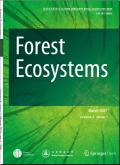Tree mycorrhizal strategies regulate diversity–productivity relationships across forest strata along soil fertility
IF 3.8
1区 农林科学
Q1 FORESTRY
引用次数: 0
Abstract
The symbiotic relationships between trees and different mycorrhizal fungi affect the biodiversity-ecosystem functioning relationships within forest communities, particularly across different strata from the understorey to the overstorey. However, current research on this relationship has not yet reached a definitive conclusion. In this study, we used regression analyses and structural equation modelling based on a 9-ha mixed broadleaved-Korean pine (Pinus koraiensis) forest plot to explore the effects of different types of mycorrhizal fungi (arbuscular mycorrhizal (AM) and ectomycorrhizal (EM) fungi) on the relationship between tree species diversity and productivity. The study found that the dominance and productivity of AM species increased in the understorey with increasing soil nutrients, whereas the productivity of EM species declined despite increasing diversity. In the overstorey, the productivity of AM species continued to increase with increasing soil nutrients, while that of EM species decreased due to increased competition. As for diversity-productivity relationships (DPRs), in the understorey, both AM and EM tree species demonstrated a positive DPR, suggesting the presence of the niche complementarity effect. In the overstorey, AM species continue to exhibit positive DPR due to their competitive advantage in nutrient-rich environments. In contrast, EM species exhibit negative DPR due to increased competition or less efficient resource use. Additionally, slope influenced forest productivity indirectly by altering the accumulation and distribution of soil nutrients, thereby affecting species distribution and growth conditions. This indirect effect highlights the potential negative impact of slope on soil nutrients within forest ecosystems, as well as its influence on the relationships between biodiversity and ecosystem functions. The study reveals how AM and EM trees influence forest productivity through distinct adaptability and competitive strategies across different forest strata, with a particular emphasis on the strata-dependent effects of mycorrhizal association on DPRs. This finding offers a new perspective on how mycorrhizal types modulate the complex relationships between biodiversity and ecosystem functions across various strata in temperate forests.
树木菌根策略沿着土壤肥力调节森林地层的多样性-生产力关系
树木与不同菌根真菌之间的共生关系影响着森林群落内生物多样性与生态系统功能之间的关系,特别是在林下到林上不同层次之间。然而,目前对这一关系的研究尚未得出明确的结论。本研究以9 ha阔叶红松(Pinus koraiensis)混交林为研究对象,采用回归分析和结构方程模型,探讨了不同类型菌根真菌(丛枝菌根(AM)和外生菌根(EM)真菌)对树种多样性与生产力关系的影响。研究发现,AM物种在林下的优势度和生产力随着土壤养分的增加而增加,而EM物种的生产力则随着多样性的增加而下降。在上层,AM物种的生产力随着土壤养分的增加而持续增加,EM物种的生产力由于竞争的加剧而下降。在林下多样性-生产力关系(DPR)方面,AM树种和EM树种均表现为正的DPR,表明存在生态位互补效应。在上层,AM物种由于在营养丰富的环境中具有竞争优势,继续表现出正的DPR。相比之下,新兴物种由于竞争加剧或资源利用效率低下而表现出负的DPR。此外,坡度通过改变土壤养分的积累和分配间接影响森林生产力,从而影响物种分布和生长条件。这种间接效应凸显了边坡对森林生态系统土壤养分的潜在负面影响,以及对生物多样性与生态系统功能之间关系的影响。该研究揭示了AM和EM树木如何通过不同森林地层的适应性和竞争策略影响森林生产力,并特别强调了菌根关联对DPRs的分层依赖效应。这一发现为菌根类型如何调节温带森林不同地层生物多样性和生态系统功能之间的复杂关系提供了新的视角。
本文章由计算机程序翻译,如有差异,请以英文原文为准。
求助全文
约1分钟内获得全文
求助全文
来源期刊

Forest Ecosystems
Environmental Science-Nature and Landscape Conservation
CiteScore
7.10
自引率
4.90%
发文量
1115
审稿时长
22 days
期刊介绍:
Forest Ecosystems is an open access, peer-reviewed journal publishing scientific communications from any discipline that can provide interesting contributions about the structure and dynamics of "natural" and "domesticated" forest ecosystems, and their services to people. The journal welcomes innovative science as well as application oriented work that will enhance understanding of woody plant communities. Very specific studies are welcome if they are part of a thematic series that provides some holistic perspective that is of general interest.
 求助内容:
求助内容: 应助结果提醒方式:
应助结果提醒方式:


